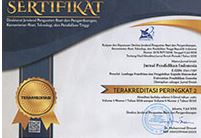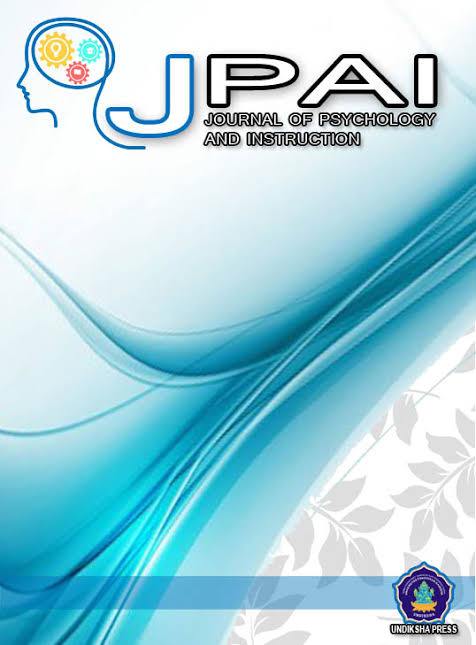The ABA Method Assisted by Picture Card Media to Improve the Speaking Ability of Group B Children with Autism
DOI:
https://doi.org/10.23887/jpai.v7i1.65333Keywords:
Speaking Ability, ABA Method, Picture Card Media, Children with AutismAbstract
Treatment options for ASD include Applied Behavior Analysis (ABA) based on learning theory and operant conditioning. Picture cards are an effective medium for object identification for autistic children. This study aims to analyze the effect of the Application of the ABA Method assisted by Picture Card Media on the speaking abilities of students with autism. This type of research is a single-case experimental design which was carried out in three phases, namely the baseline phase (A1), the intervention phase (B) and the baseline phase (A2). The subjects in this study were two children of group B. The collection of research data on the speaking ability of students with autism used observation and interview methods with an observation checklist sheet instrument. Research data were analyzed using descriptive statistical analysis methods and data presentation was presented visually (visual inspection) in graphical form. The results of data analysis showed that there was a decrease in the frequency of speaking ability and an increase in the frequency of speaking ability from the baseline phase (A1) with an average of 6 to 14.18 in the intervention phase (B) and an increase in the frequency of speaking skills of students with autism during the ABA approach intervention with the help of media picture cards in learning stopped (A2) with an average of 18.7. Based on the results of this study it can be concluded that the ABA method approach with the help of picture card media in learning the speaking skills of students with autism Group B.
References
Anggreni, P. F., Asri, I. A. S., & Ganing, N. N. (2017). Pengaruh Model Pembelajaran Kooperatif Tipe Think- Pair-Share ( Tps ) Berbantuan Media Kartu Bergambar Terhadap Penguasaan Kompetensi Pengetahuan Ips Siswa Kelas V Gugus Letkol Wisnu. Mimbar PGSD, 5(2), 1–10. https://doi.org/10.23887/jjpgsd.v5i2.10645.
Arnold, S., & Reed, P. (2016). Reading assessments for students with ASD: a survey of summative reading assessments used in special educational schools in the UK. British Journal of Special Education. https://doi.org/10.1111/1467-8578.12127.
Arnold, S., & Reed, P. (2019). Measuring the word recognition abilities of children who are both verbal and nonverbal with ASD using a traditional paper-based and a novel digital test format. British Journal of Special Education. https://doi.org/10.1111/1467-8578.12279.
Dani, R. A. (2018). Pendekatan Pembelajaran Anak Autis Dengan Menggunakan Metode Floor Time Di Sekolah Dasar Kec.Situbondo Kabupaten Situbondo. JRPD (Jurnal Riset Pendidikan Dasar), 1(2), 78–83. https://doi.org/10.26618/jrpd.v1i2.1564.
Dewi, N. N. A. I., & Retnoningtyas, D. W. (2019). Efektivitas Applied Behavior Analysis terhadap Kemampuan Interaksi Sosial Murid SLB dengan Gangguan Spektrum Autis di Bali. Jurnal Psikologi Mandala, 3(2), 21–28. https://doi.org/10.36002/jpm.v3i2.1093.
Dorji, R. (2015). Teaching Social Skills to Children with Autism Spectrum Disorder,(ASD): A Case Study of Selected Mainstream Primary Schools in one Borough of London, UK. Centre for Educational Research and Development Journal, Paro College of Education, 16(2), 18–36. https://etda.libraries.psu.edu/files/final_submissions/2888.
Febiola, S., & Yulsyofriend, Y. (2020). Use of Flash Card Media on Early Childhood Speaking Ability. Journal of Education Tambusai, 4(2). https://doi.org/10.31004/jptam.v4i2.566.
Febtriko, A., Yulianti, W., & Rahayuningsih, T. (2019). Pemanfaatan Ubtech Humanoid Robot Sebagai Media Pembelajaran Kepada Guru Menuju Era Revolusi Industri 4.0 Dibidang Pendidikan Untuk Anak Autis Di Pekanbaru Lab School. Jurnal Pengabdian Masyarakat Multidisiplin, 3(1), 42–52. https://doi.org/10.36341/jpm.v3i1.1022.
Fikri, M., Ananda, M. Z., & Faizah, N. (2021). Kendala Dalam Pembelajaran Jarak Jauh di Masa Pandemi Covid-19 : Sebuah Kajian Kritis. Jurnal Education and Development, 9(1), 145–148. https://doi.org/10.37081/ed.v9i1.2290.
Guo, Y., Dynia, J. M., & Lai, M. H. C. (2021). Early childhood Special education teachers’ self-efficacy in relation to individual children: Links to children’s literacy learning. Early Childhood Research Quarterly, 54, 153–163. https://doi.org/10.1016/j.ecresq.2020.09.002.
Hakiman, H., Sumardjoko, B., & Waston, W. (2021). Religious Instruction for Students with Autism in an Inclusive Primary School. International Journal of Learning, Teaching and Educational Research, 20(12), 139–158. https://doi.org/10.26803/IJLTER.20.12.9.
Hambly, C., & Fombonne, E. (2012). The impact of bilingual environments on language development in children with autism spectrum disorders. Journal of Autism and Developmental Disorders, 42(7), 1342–1352. https://link.springer.com/article/10.1007/s10803-011-1365-z.
Hamidaturrohmah, & Mulyani, T. (2020). Strategi Pembelajaran Jarak Jauh Siswa Berkebutuhan Khusus Di Sd Inklusi Era Pandemi Covid-19. ELEMENTARY: Islamic Teacher Journal, 8(2), 247. https://doi.org/10.21043/elementary.v8i2.7907.
Happé, F., & Frith, U. (2014). Annual research review: Towards a developmental neuroscience of atypical social cognition. Journal of Child Psychology and Psychiatry and Allied Disciplines, 55(6), 553–577. https://doi.org/10.1111/jcpp.12162.
Holiah, I. (2022). Penguatan Kompetensi Guru Melalui Pengembangan Keprofesian Berkelanjutan. Eduvis : Jurnal Manajemen Pendidikan Islam, 7(1), 97–106. https://www.neliti.com/publications/376667/penguatan-kompetensi-guru-melalui-pengembangan-keprofesian-berkelanjutan.
Istifarroh, I., & Nugroho, W. C. (2019). Perlindungan Hak Disabilitas Mendapatkan Pekerjaan Di Perusahaan Swasta Dan Perusahaan Milik Negara. Mimbar Keadilan, 12(1), 21. https://doi.org/10.30996/mk.v12i1.2164.
Kincaid, D. L., Doris, M., Shannon, C., & Mulholland, C. (2017). What is the prevalence of autism spectrum disorder and ASD traits in psychosis? A systematic review. Psychiatry Research, 250, 99–105. https://doi.org/10.1016/j.psychres.2017.01.017.
LeBarton, E. S., Iverson, J. M., LeBarton, E. S., & Iverson, J. M. (2013). Fine motor skill predicts expressive language in infant siblings of children with autism. Developmental Science, 16(6), 815–827. https://doi.org/10.1111/desc.12069.
Mahanani, T. D. (2020). Penggunaan Kartu Kata Bergambar Untuk Meningkatkan Ketrampilan Berbicara Anak Autis. Pendidikan Khusus, 1–5. https://ejournal.unesa.ac.id/index.php/jurnal-pendidikan-khusus/article/view/35032.
Mahoney, M. W. M. (2019). Peer-Mediated Instruction and Activity Schedules: Tools for Providing Academic Support for Students With ASD. Teaching Exceptional Children, 51(5), 350–360. https://doi.org/10.1177/0040059919835816.
Nurcholis, R. A., & Istiningsih, G. (2021). Problematika dan Solusi Program Literasi Baca-Tulis Siswa Kelas Rendah di SD Negeri Butuh. Jurnal Ilmiah Profesi Pendidikan, 6(2), 189–195. https://doi.org/10.29303/jipp.v6i2.206.
Padmadewi, N. N., & Artini, L. P. (2017). Teaching english to a student with autism spectrum disorder in regular classroom in Indonesia. International Journal of Instruction, 10(3), 159–176. https://doi.org/10.12973/iji.2017.10311a.
Pradana, P. H., & Gerhni, F. (2019). Application of Flash Card Learning Media to Improve Children’s Language Development. Journal of Education and Instruction (JOEAI), 2(1), 25–31. https://doi.org/10.31539/joeai.v2i1.587.
Rahayu, T., & Mayasari, T. (2018). Profil kemampuan awal literasi digital dalam pembelajaran fisika siswa SMK Kota Madiun. Quantum: Seminar Nasional Fisika, Dan Pendidikan Fisika, 431–437. http://www.seminar.uad.ac.id/index.php/quantum/article/view/294.
Ratnasari, E. M., & Zubaidah, E. (2019). Pengaruh Penggunaan Buku Cerita Bergambar Terhadap Kemampuan Berbicara Anak. Scholaria: Jurnal Pendidikan Dan Kebudayaan, 9(3), 267–275. https://doi.org/10.24246/j.js.2019.v9.i3.p267-275.
Risna Resnawaty, S. A. S. (2017). Program Keluarga Harapan ( Pkh ): Antara Perlindungan Sosial. Prosiding Ks: Riset & Pkm, 4(1), 1–140. https://doi.org/10.24198/jppm.v4i1.14213.
Safitri, H., & Ratulangi, R. (2018). Meningkatkan Kemampuan Kognitif Anak Dengan Menggunakan Media Kartu Bergambar Pada Kelompok B TK Wulele Sanggula Ii Kendari. Jurnal Riset Golden Age Paud UHO, 1(1), 22. https://doi.org/10.36709/jrga.v1i1.2849.
Sahin, N. T., Abdus-Sabur, R., Keshav, N. U., Liu, R., Salisbury, J. P., & Vahabzadeh, A. (2018). Case Study of a Digital Augmented Reality Intervention for Autism in School Classrooms: Associated With Improved Social Communication, Cognition, and Motivation via Educator and Parent Assessment. Frontiers in Education, 3. https://doi.org/10.3389/feduc.2018.00057.
Sanusi, R., Dianasari, E. L., Khairiyah, K. Y., & Chairudin, R. (2020). Pengembangan Flashcard Berbasis Karakter Hewan untuk Meningkatkan Kemampuan Mengenal Huruf Anak Tunagrahita Ringan. Jurnal Pendidikan Edutama, 7(2), 37. https://doi.org/10.30734/jpe.v7i2.745.
Sari, C. R., Suryana, D., & Pransiska, R. (2019). Keterlambatan Bicara Anak Usia 5 Tahun. Prosiding Seminar Dan Diskusi Nasional Pendidikan Dasar “Menyongsong Transformasi Pendidikan Abad 21,” 99–104. https://ejournal.unesa.ac.id/index.php/jurnal-pendidikan-khusus/article/view/35032.
Schuetze, M., Cho, I. Y. K., Vinette, S., Rivard, K. B., Rohr, C. S., Eycke, K. Ten, Cozma, A., McMorris, C., McCrimmon, A., Dewey, D., & Bray, S. L. (2019). Learning with individual-interest outcomes in Autism Spectrum Disorder. Developmental Cognitive Neuroscience, 38, 100668. https://doi.org/10.1016/j.dcn.2019.100668.
Sembiring, S. B., Agung, A. A. G., & Antara, P. A. (2021). Media Audio Visual dengan Tema Lingkunganku Terhadap Keterampilan Berbicara Anak di Depan Umum. Jurnal Pendidikan Anak Usia Dini Undiksha, 9(3), 371. https://doi.org/10.23887/paud.v9i3.40134.
Sproston, K., Sedgewick, F., & Crane, L. (2017). Autistic girls and school exclusion: Perspectives of students and their parents. Autism and Developmental Language Impairments, 2. https://doi.org/10.1177/2396941517706172.
Supriatna, A., & Ediyanto, E. (2021). The Implementation of Multisensory Technique for Children with Dyslexia. IJDS: Indonesian Journal of Disability Studies, 8(01), 279–293. https://doi.org/10.21776/ub.ijds.2021.008.01.17.
Suryani, I., & Dewi, N. F. K. (2018). Aplikasi Terapi Untuk Anak Autisme Dengan Metode ABA (Applied Behavior Analysis) Berbasis Media kartu Bergambar dan Benda Tiruan. Ceria: Jurnal Program Studi Pendidikan Anak Usia Dini, 6(1), 16. https://doi.org/10.31000/ceria.v6i1.554.
Susantini, N. L. (2021). Media Flashcard Berbasis Multimedia Interaktif untuk. Jurnal Pendidikan Anak Usia Dini Undiksha, 9(3), 439–448. https://doi.org/10.23887/paud.v9i3.37606.
Wen, J. M., Do, H. D., Liu, E. Z. F., Lin, C. H., & Huang. (2020). SK Educational board game and flashcard: Which is better for learners at beginner level of Chinese language? International Journal of Serious Games, 7(4), 89–104,. https://doi.org/10.17083/ijsg.v7i4.347.
Zhang, L., Warren, Z., Swanson, A., Weitlauf, A., & Sarkar, N. (2018). Understanding performance and verbal-communication of children with ASD in a collaborative virtual environment. Journal of Autism and Developmental Disorders, 48(8), 2779–2789. https://doi.org/10.1007/s10803-018-3544-7.










